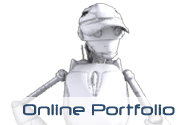Danny got inspired by Neil's hamster, which in turn inspired me. I mean its a hamster controlled robot for crying out loud. There is no way this is gonna end well and I want to be part of it. Danny's concept is on the lower right of some of the renders. Still a W.I.P. Start at the bottom of the post and work your way up, to see my work flow.
Ok so as you can see, I enjoy this phase of modeling. Its the little details that count. Bolts, nuts, wires, tubes, gears, and rivets, you make one and duplicate the hell out of it. Using a process known as kit-bashing, I used parts from older models that are close to the shape I need and rework them into this new one. No sense in always starting a new piece from a cube. Save yourself some time and kit-bash.


Here's where the fun comes in. Details, details, details. Personally I get carried away and begin deviating from Danny's concept. In most cases (especially when working from sci-fi concepts); As an artist you have to take some liberties. I took some liberties in applying some real world functionality to this robot. Let me re-phrase that, I faked it to look like it would work in the real world. Granted most of it is going to be hidden, but I don't mind spending 3-4hrs on a section of a model that's almost never going to be visible. It just makes me feel good about myself knowing its there.

Using a simple lighting rigg, I check for problem areas. You might notice that you have all this detail on your model and it looks fantastic in the default viewport, but once lights and shadows come into play you realize that your geometry doesn't flow as you had hoped. In my case, Danny pointed out that the air vents in the robot's chest were too big and had warped edges. His heels also seemed too "dough-ey" for my taste.

Once the overall form has been fleshed out, I begin implementing some hard surface modeling techniques. At the same time I add a new level of detail through out the piece. I never focus on just one part. The same applies to drawing. You want to keep moving around the piece. The more time you spend over-developing an area during this phase makes the end piece look odd. Certain spots would look great while others have obviously been neglected.
Here I began using basic geometric shapes such as spheres, pyramids, and cylinders to block out the silhouette of the character. At this point I am not overly concerned with detail. Form is what counts. Ok so I lied. I got carried away and put some details in his knees...sue me.
I started off with simple Spline shapes to get a base form and pose for the character. Doing this not only helps me maintain proportions, but also helps me get a good sense of the character's mannerisms. I was taught to model characters in a "T" pose. I find doing that boring sometimes and the character seems lifeless, no matter how much detail or character specific traits I add during the modeling process. As you can see, the pose I chose gives a hint of arrogance and badass-ness. The big pay off for me is that underneath all that its just a hamster.
Subscribe to:
Post Comments (Atom)

About Me

- Bakia Parker
- I am currently a Freelance 3D Modeler. My work is strongly influenced by my obvious obsession with anything sci-fi and mechanical. The subject matter in my artwork has always been conceptual machinery (robots, bikes, cars, spaceships, and so on). I take great pride in applying my understanding of real world machine functionality and look to my pieces. The end results are highly detailed production and real-time ready models. The life of an artist is a non-stop learning process filled with overcoming obstacles, challenges and meeting deadlines. If there is one thing the art world has taught me, it’s that “You never know what you are capable of unless you are pushed beyond your limits.”
Fellow Artists
- 3D Gundam Models
- Alexa
- Analytical Figure Drawing
- Brian Muelhaupt
- Bryan "The Kaiser" Tillman
- Chad White
- Chris Scott
- Christa Frye
- Ciaee
- Danny Araya
- David Colman
- David Silva
- Enrique Rivera
- Eric Scharf
- Felicia Woodward
- Fer Fer
- Gio Nakpil
- Greg Peltz
- Hannah
- Hilda "The Explorer" Torres
- Hilduh "The Explorer" Torres Blog
- Jerald "Booty" Lewis II
- Joe Weatherly
- John S ArtHole
- Jon Stuart
- Joshua The James
- Kenny Woods
- Krispaaaaaay
- Krispaaaaaay No_2
- Louis Gonzalez
- Mark
- Matt "The Crayon" Conti
- Menty
- Nico Di Mattia
- Niel Bear
- OMG its Karrrrrie
- Pencil Test Depot
- Rad How To
- Rafael
- Rambo II
- Robyn Williams
- Sam Ellis
- Scott Brown
- Sunny K
- Susie Jang
- Syd Mead Concept Art
- Tariq Lateef
- The Art Centre
- Todd Churn
- Tom Davis
- Tom Davis Blog
4 comments:
Sencillamente ...GENIAL!!
Gracias, el...cirilo.
OH SNAP
Here is a link to the hamster that pilots this awesome sauce.
http://nerfcommie.deviantart.com/art/Hamster-Pilot-146331935
Post a Comment